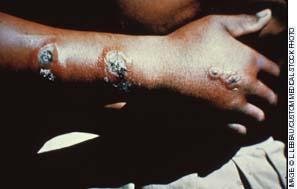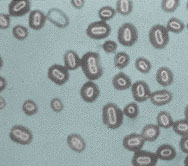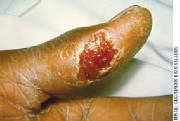|
What is bioterrorism?
Sidney Dobrin, Christopher
Keller and Christian Weisser define bioterrorism as "the intentional release of germs or other biological substances such
as toxins and poisons that can cause illness and death among people" (492). These biological
substances are microorganisms; bacteria or viruses that have the ability to infect humans. These microbes invade their
hosts by being breathed in, ingested or getting into the body via mucous mebranes, like the eyes, or cuts in the skin.
They may cause various symptoms from fatigue to internal bleeding (Frequently Asked Questions). Not all of them
have a high mortality rate (Frequently Asked Questions). Some are can be cured using common antibiotics (Anthrax
Fact Sheet, Plague Fact Sheet, Tularemia Fact Sheet), others can be prevented with vaccines (Smallpox Fact Sheet)
and treating symptoms is the only way to deal with a few (Botulism Fact Sheet, Viral Hemorrhagic Fever Fact Sheet). Six
of the most well-known biological weapons are anthrax, botulism, plague, smallpox, tularemia and viral hemorrhagic fever (Information
for the Public).
Anthrax
Anthrax is caused by a bacterium
that naturally occurs in soil. The illness may be contracted via skin contact
with infected animals or animal products, inhalation of the bacterial spores or gastrointestinally by eating undercooked meat
from infected animals. Anthrax spores from Bacillus anthracis can survive
for years and can be made into a dry form. The symptoms of the disease vary depending
on the method of infection. Skin or cutaneous anthrax may cause a small sore
that becomes a blister, then a skin ulcer. The respiratory form may cause flu-like
symptoms that can lead to cough, chest discomfort, fatigue, shortness of breath, and possibly meningitis, chest infection,
shock, and death. Gastrointestinal anthrax can cause loss of appetite, nausea,
bloody diarrhea, fever and severe stomach pain. There is no vaccine for the general
public, but anthrax can be prevented and treated using several common antibiotics. (Anthrax Fact Sheet)
| skin ulcers caused by anthrax |

|
| This image was taken from: http://www.patientcareonline.com/patcare/article/articleDetail.jsp?id=11 |
Botulism
The organism that causes
botulism, Clostidium botulinum, is also found naturally in soil and a single bacterium can survive years in the form
of a spore. It produces a nerve toxin that causes muscle paralysis. The bacteria gain entry into the body systems via ingestion (food), the intestinal tract, or wounds. The bacteria may be aerosolized or put into the food supply. The symptoms of botulism include drooping eyelids, slurred speech, double vision, blurred vision, dry mouth
or muscle weakness. There is no vaccine for botulism, but it can be treated with
antitoxins and supportive hospital care. (Botulism Fact Sheet)
| C. botulinum cells |

|
| This image was taken from: http://www.patientcareonline.com/patcare/article/articleDetail.jsp?id=11 |
Plague
Yersinia pestis
is found world-wide in rodents and their fleas, and it causes the plague. The
disease has three forms. Bubonic plague is an infection of the lymph glands and
is caused by bites from infected fleas or contact between broken skin and contaminated items.
Symptoms can include fever, chills, swollen, tender lymph glands, headache and exhaustion. Pneumonic plague is an infection of the lungs and is causes by breathing in air-born bacterial cells. Fever, chills, headache, weakness, pneumonia, chest pain, cough, shortness of breath,
shock and death can result. Septicemic plague is a blood infection in which the
bacteria multiply in the blood. This form cannot be transmitted from person to
person. Individuals with this form may experience, fever, chills, abdominal pain,
shock and bleeding into the skin and other organs. There is no vaccine for the
plague, but common antibiotics are used to treat it. (Plague Fact Sheet)
| Y. pestis under a light microscope |

|
| This image was taken from: http://eee.uci.edu/clients/bjbecker/PlaguesandPeople/lecture4.html |
Smallpox
Smallpox is caused by the
variola virus which no longer is present on the globe thanks to a world-wide vaccination campaign in the early part of the
20th century. Possible symptoms are headache, body ache, fever, fatigue
and vomiting. A rash of small red spots, that eventually form sores and break
open, develops in the mouth. Then, a skin rash forms, beginning on the face and
spreading to the rest of the body. This will turn into raised, fluid-filled pustules
that scab over. There is a vaccine available, but it will only be administered
to the public in the case of an outbreak. No medications exist to treat smallpox
once the rashes develop. However, supportive care increases the rate of recovery.
(Smallpox Fact Sheet)
| progression of smallpox rash |

|
| This image was taken from: http://users.wfu.edu/turnaw2/smallpoxsymptoms.htm |
Tularemia
Francisella tularensis
is the organism that causes tularemia and is commonly found in animals, especially rabbits.
The bacteria do not spread from person to person, but the disease can be contracted through infected flea bites, contact
with infected animals, consuming contaminated food or breathing in the bacteria. Fever,
headache, chills, cough, chest pain, diarrhea, sore throat, vomiting, stiff neck, back pain and abdominal pain are all associated
with tularemia. No vaccine is available, but the illness can be treated using
antibiotics. (Tularemia Fact Sheet)
| tularemia infection |

|
| This image was taken from: http://www.patientcareonline.com/patcare/article/articleDetail.jsp?id=11 |
Viral Hemorrhagic Fever
Viral hemorrhagic fever is caused by several
different types of viruses. The Ebola and Marburgviruses are the
most likely to be used in bioterrorism. The viruses are passed from rodents,
fleas and ticks to humans. Some viruses can be spread from person to person by
contact with contaminated objects. The symptoms vary, but fatigue, muscle ache,
fever, head ache, sore throat and weakness are common. Some individuals may experience
bleeding under the skin, in organs, or from the mouth, eyes or ears, shock, seizure, nervous system breakdown and kidney failure. There are only two vaccines available for two of the many viruses that cause viral
hemorrhagic fever. Supportive care is the only known treatment. (Viral Hemorrhagic
Fever Fact Sheet)
| Ebola Virus |

|
| This image was taken from: http://bepast.org/dataman.pl?c=flib&dir=docs/photos/ebola/ |
Essentials
Patience and cooperation are imperative. Emergency
and government agencies in the area have disaster plans ready to enact. It is
important to stay informed in the event of a biological attack. Community leaders
and emergency personnel will likely give specific information about how to stay safe and what actions to take during an attack. In this instance, television, radio, newspapers and the internet will all be vital
in order to stay informed. (Information for the Public)
It is also a good idea to have at least a three-day supply of food, water, medications and other necessities
on hand. The best way to prevent many infections due to bioterrorism, and even everday life, is to use proper
hygiene, including frequent handwashing and thoroughly cleaning cooking surfaces after meat preparation. (Information
for the Public)
|

